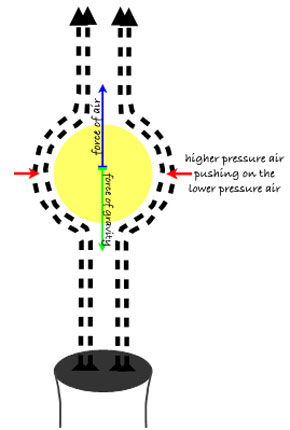Floating Ping-Pong Balls
Balancing air pressure and gravity, we can make a ping-pong ball float in mid-air. Along the way, we'll learn about lift — the force that keeps aircraft up as they fly across the world.

What You Need
- A ping-pong ball
- A hairdryer
What to Do
Turn on your hair dryer to the highest setting and point it straight up. Gently place the ping-pong ball within the flow of air from the hair dryer and balance it in the air stream.
Test your skills: see how far you can tilt the hair dryer to the side before you lose the ping-pong ball. Why does the ball stay in the air stream?
What's Going On?
The ping-pong ball will fly up with the air from the hair dryer until it reaches a point of balance – this is where the force of gravity (which pushes the ping-pong ball down) is equal to the force of the air (which is pushing the ping-pong ball up).
The ping-pong ball stays within the column of air coming from the hair dryer because of air pressure. The air coming from the hair dryer is moving faster than the air around it, and this means that it also has a lower air pressure than the air around it. (We know this thanks to our old friend Bernoulli, who discovered this relationship back in the 1700’s). So the ball is kept within the column of lower air pressure because of the higher-pressure air surrounding it.

Test It!
Where else do we use air pressure to keep things afloat? Consider airplanes: the shape of an airplane wing causes air to move faster over the top of it than it does under the wing. As we saw with the ping-pong ball, this means that there will be lower air pressure above the wing than below it, which will push the airplane up and keep us afloat!
- Aliya Merali














